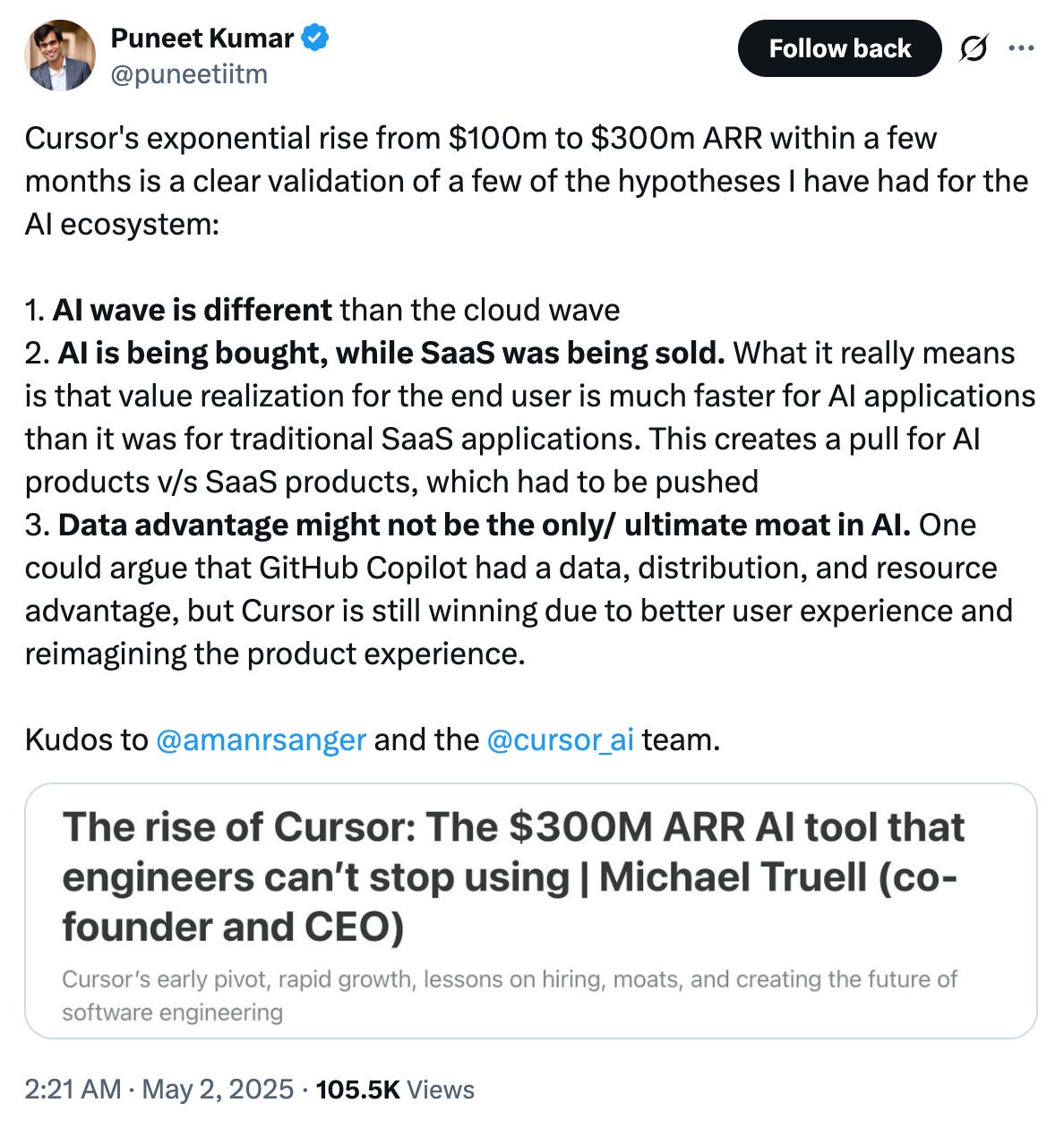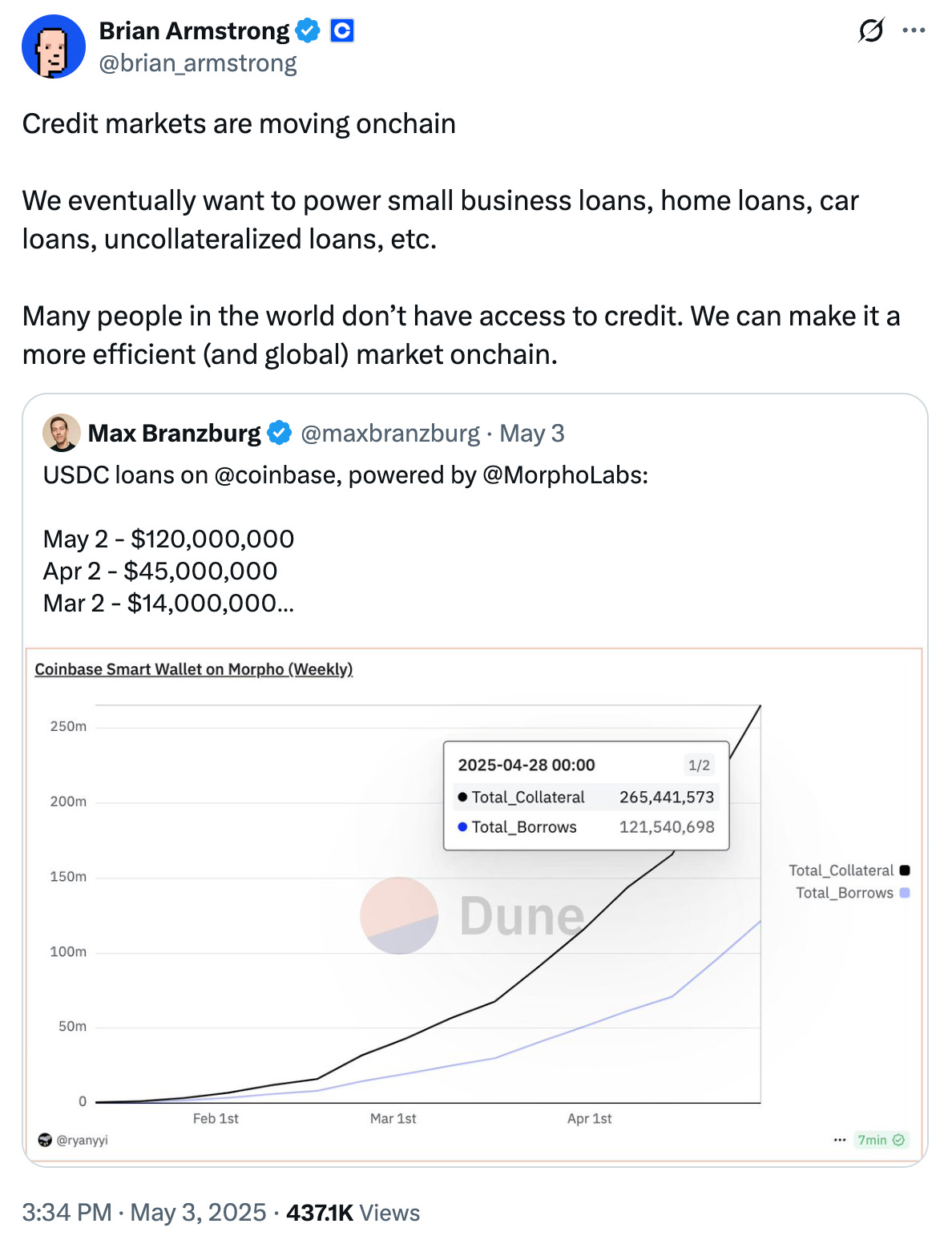What I Read This Week…
Berkshire Hathaway has net sold for 10 quarters, Google launches "AI mode", court ruling allows developers to bypass Apple' App Store fees, and the current state of the U.S. rare earth supply chain
Watch All-In Interview with Secretary of Agriculture Brooke Rollins
Read our Deep Dive: A Primer on Stablecoins
Read our Deep Dive: A Primer on Cryptocurrencies
Caught My Eye…
Berkshire Hathaway has been a net seller of stocks for ten consecutive quarters, trimming or exiting positions, including Apple, Bank of America, and Chevron, while fully exiting holdings like HP and Paramount Global. At the 2025 annual shareholder meeting, Buffett explained that the firm is waiting for “extraordinarily attractive” opportunities, preferring to hold cash rather than overpay in an overheated market. As a result, Berkshire’s equity portfolio has become more concentrated, with Apple (still its largest holding), Coca-Cola, American Express, and Occidental Petroleum anchoring Warren’s long-term convictions. Meanwhile, the company’s cash pile has increased to an unprecedented $348 billion, which is roughly equal to the total reserves held by all U.S. commercial banks at the Federal Reserve. Warren also announced he will step down as CEO by the end of 2025. Under his leadership, Berkshire Hathaway delivered a return of 5,502,284% since 1965, compared to just 39,054% for the S&P 500 over the same period.
Google’s rollout of AI Mode marks a shift in its core search strategy, transforming Search from a results engine into a task-oriented AI assistant. This mode offers conversational inputs, including voice and images, and delivers visually rich answers with product cards, local business info, and session memory similar to Search’s current UI. AI Mode works by combining Gemini with structured real-time data from across its services, including Search index, Maps, Shopping Graph, and local business databases. When a user enters a query, such as “best foldable camping chair under $100,” AI Mode generates a clear, concise answer formatted in visual cards, which are clickable, tappable, and linked to actions like visiting a store, calling the business, or placing an order. Users can ask follow-up questions without starting over, and a memory panel on the left-hand side (on desktop) shows previous sessions, letting users revisit or refine their queries over time. This launch is central to Google’s ecosystem play: by integrating shopping, trip planning, and local discovery directly into the AI layer, Google keeps users inside its platform as they compete with OpenAI and other platforms for more and more tasks that traditionally people searched for.
The U.S. court upheld a ruling requiring Apple to allow developers to include external payment links for apps downloaded from the App Store. This ruling enables developers to bypass Apple’s in-app payment system and its 30% fee, long derided as the “Apple tax”, by using alternatives like Stripe, which charges just 2.9%. Stripe responded immediately with a developer-friendly SDK, making it easier than ever to integrate external payments and reclaim margin. After Apple tried to blunt the impact by introducing a new 27% “external processing fee,” the court further mandated that Apple must eliminate its 27% external processing fee as well, representing around $20 billion annually. More broadly, as AI reshapes how people interact with their phones and software, the App Store may lose relevance under its current design. Apple must evolve or risk becoming a toll booth that fewer developers will use.
A month ago, China imposed new export restrictions on heavy rare earth elements, such as dysprosium (Dy) and terbium (Tb). What are dysprosium and terbium, and what does the supply chain for these two elements look like today? Dysprosium and terbium are heavy rare earth elements used in high-temperature-resistant permanent magnets, which are essential components in electric vehicles, wind turbines, and defense systems. These two elements are extracted from ionic clay deposits through surface mining operations in southern China and northern Myanmar. After mining, the clays undergo chemical leaching to yield a rare earth concentrate containing a mixture of elements. This concentrate must then be processed through solvent extraction to isolate and purify individual oxides. Nearly all commercial separation and refining capacity today is located in China, making it the dominant global supplier. Once purified, the oxides are converted into metallic alloys through metallization. These alloys are then used in the manufacture of neodymium-iron-boron (NdFeB) magnets, which are produced in China, Japan, and South Korea. Finally, the magnets are integrated into end-use systems ranging from EV drivetrains and wind turbine generators to industrial robotics and U.S. defense platforms such as missile guidance systems and fighter aircraft. This multi-step chain remains geographically concentrated and strategically fragile, with China controlling nearly all high-value stages today.
Other Reading
President Trump’s Budget Priorities (The White House)
U.S, Lawmakers Urge SEC to Delist Alibaba and Chinese Companies (Financial Times)
Governor Newsom deploys AI to Improve Efficiency in CA (Governor Gavin Newsom)
Google Open to Sharing Real-Time Bids but Rejects Breakup (Adweek)
Jeff Bezos to Sell Up to $4.75B Amazon Stock (Financial Times)
Meta's Llama API, Accelerated by Groq, 'Raises Bar for Model Performance' (TechRepublic)
Huawei’s Global Rise and the Strategy Behind It (High Capacity)
Chinese AI Startup Manus Scores Funding at $500 Million Value (Bloomberg)
LA Times Continues Layoffs (The Wrap)
The Future Of Solar Doesn’t Track The Sun (Terraform Industries)
The US Approves CRISPR Pigs for Food (MIT Technology Review)
On X…










Fascinating! I’m Harrison, an ex fine dining industry line cook. My stack "The Secret Ingredient" adapts hit restaurant recipes (mostly NYC and L.A.) for easy home cooking.
check us out:
https://thesecretingredient.substack.com
Legacy financial press is compulsive in spinning the macro numbers, to arrive at a punchier headline. Earlier reporting of the Berkshire Hathaway "cash" position of around $350B as 5% of the Treasuries actually compared to the totals of the issued BILLs, 52 week and shorter maturities. Those are maybe 20% of all the Treasuries held privately.
FED's own balances are intentionally opaque and reported in bulk. How on a given day it totals the accounts designated as "reserves held by all U.S. commercial banks at the Federal Reserve" may warrant scrutiny. There is a reason the organization has never been audited, while it shuffles trillions between various programs and accounts. For example, the details of the most recent activities of the Discount Window extend to 2023. In recent years FED ran a dozen credit 'facilities', like PDCF, CPFF, and MMLF. Only a year ago it wound down BTFP, instituted in March 2023 in response to the SVB crisis.
It's bulking-up Federal Reserve Standby Facility (FRSF/SRF). Hedge funds engaging in the 'basis trade' have been hit with major margin calls mid-April, due to a rapid and unexpected bump in the yields of longer-term debt. The spread between the price of a Treasury and a matching derivative had jumped, and now those funds may need to be bailed out.
FED watchers track numbers being released daily and weekly. 20 US Treasury broker-dealers, including JPMorgan Chase, BofA, and Wells Fargo, likely tell the FED what to do, before and after the daily auctions. But regular investors only get 8 official updates a year, when Powell recites what transpired in the latest Federal Open Market Committee (FOMC) meeting, and the press regurgitates it in sound bites. The next meeting starts tomorrow, Wed.